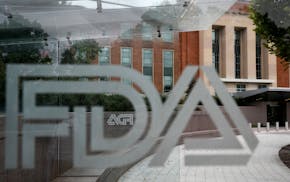It was November 2012, and Hubert Joly was barely two months into his tenure as Best Buy's CEO.
The company's stock had sunk to below $15, a 10-year low, as sales were plummeting. Its founder was putting together a bid to take the company private again. And many on Wall Street doubted the company would survive the mounting threat of Amazon.com.
Hurricane Sandy was battering the East Coast, forcing the retailer to postpone a meeting in New York with investors. It rescheduled it a couple weeks later. That was where Joly presented his solution, his Renew Blue turnaround plan, now held up as one of the success stories of the modern era of retailing.
On Wednesday, Joly declared Renew Blue officially completed.
"We didn't die: check," he said as he introduced the Richfield-based retailer's next phase, Best Buy 2020: Building the New Blue.
In an age when online shopping has driven other companies out of business, Joly acknowledged Best Buy has plenty of challenges ahead especially amid a declining electronics market. But he said the company is now turning its mind-set to growth.
Best Buy's stock is now trading in the mid-$40 range. It's been gaining marketshare and has posted small upticks in comparable sales for the past three years after three years of declines. And it's become profitable again, improving margins and earnings per share.
Signs proclaiming the new chapter and slogan have gone up in recent weeks around Best Buy's Richfield headquarters.
"In my turnaround manual, which I have, you don't start with strategy," Joly told the Star Tribune in a recent interview. "You start with improving what you have. Then you work on strategy later, and that's where we are."
He continued: "Now we're focused on growth and trying to define what we want to look like when we grow up. It's an exciting phase because we've earned the right to not just look at the next quarter, but look at the next several years and strategically look at the customer needs, the opportunities and the role we want to play."
Joly could have pursued flashy acquisitions or massive store remodels to turn around the business when he first came on board, said Carol Spieckerman, a retail consultant. Instead, he made a wise move to focus first on improving the fundamentals of the business.
"Best Buy resisted the temptation to chase shiny objects," she said. "That takes a lot of restraint. As a result of that restraint, they're better poised to start chasing after some of them now."
When Joly first joined Best Buy in September 2012 from hospitality and travel giant Carlson, he moved quickly.
Within weeks, he rolled out a pilot program (which later became permanent) to match online prices of Amazon and others. The idea was to help ease concerns about customers coming to its stores, checking out products and then buying them for less elsewhere online.
He stood on a stage at Best Buy Theater in Times Square on Nov. 13, 2012, and laid out the five pillars of the Renew Blue plan, which included improving the customer experience, energizing employees, deepening relationships with vendors and increasing return on investment through cutting costs and growing sales.
They would focus on the "low-hanging fruit," for example the fact that only about 1 percent of visitors to BestBuy.com actually bought something on the site.
"The good news is that most of our problems are self-inflicted and we can and will fix them," he told investors.
Some analysts were skeptical. But over the next year, Best Buy's stock more than tripled.
Joly made peace with Dick Schulze, the company's founder, who never followed through with his buyout plan and instead became the company's chairman emeritus.
He hired former Williams Sonoma executive Sharon McCollam as his finance chief. She wooed back investors and boosted their confidence.
Together, they began making $1 billion in cost cuts, starting with hundreds of corporate layoffs, including 400 employees at headquarters in one fell swoop. Other savings came through tweaking the supply chain. The venture capital unit also was shut down.
Best Buy reined in its global footprint. In 2013, it ended its joint venture with Carphone Warehouse in Europe. In 2014, Best Buy sold its 184-store chain of Five Star stores in China. And in 2015, it consolidated its Canadian enterprises, closing 66 stores and rebranding its Future Shop stores to the Best Buy name.
Another key move was letting some of its biggest brands such as Samsung, Sony and Microsoft set up mini-shops inside of Best Buy stores, reallocating space away from CDs and DVDs toward smartphones, tablets and TVs.
"The vendor relationships were obviously a huge game changer for these guys," said Charlie O'Shea, an analyst with Moody's. "When vendors realize the concept works and put the manpower, the dollars and their reputation on the line — that's a pretty powerful validation of the strength of a retailer."
As far as online goes, Best Buy vastly improved its website and upgraded its app to include features such as live chats and curated customer reviews in an easy-to-read format.
It also has overhauled its supply chain, being one of the first retailers to enact chain-wide ship-from-store capabilities that get online packages to customers faster and more cost efficiently instead of relying on more distant fulfillment centers. Today, about 40 percent of Best Buy's online orders are either picked up in stores or shipped from the store.
As a result, in the past four years, Best Buy has more than doubled its online sales from 7 percent to 13 percent of U.S. revenue. Online sales now total $5 billion.
Still, Dave Brennan, a retailing professor at the University of St. Thomas, said the turnaround has been mixed. The Amazon threat hasn't gone away. And while Best Buy has made major strides in improving its profitability, it still has yet to show substantial top-line growth.
"Longer term, they're going to have to find a way to grow the company," he said. "That's the challenge."
Executives said last week that a shortage of in-demand products and delayed tax refunds would likely lead to lower sales in the first quarter of this year. And they forecast flat growth and operating margins this year as the consumer electronics industry as a whole is expected to have a third down year in a row.
Best Buy 2020 is partly aimed at helping the company find more stable revenue streams that are not as dependent on various up-and-down product cycles. Cutting costs — such as through refurbishing and reselling returned or damaged goods — to help offset inflation and to fund future investments continues to be a goal.
The new plan looks to three areas for growth. The first is hopping on emerging categories such as connected home and appliances and further blending its in-store and digital experiences.
The second area is services and solutions such as the Geek Squad. Best Buy began piloting an in-home adviser program in four markets last year in which experts come to customers' homes and give them a free consultation on how to better utilize technology in their homes. Best Buy will slowly roll that program out to more parts of the country this year.
"It's a good illustration … of where the company is going," Joly told investors last week. "We go beyond just selling products and solving real customer needs, touching people's lives."
Finally, Joly sees room for growth in Canada and Mexico where Best Buy has 187 and 25 stores, respectively. It is ramping up remodeling stores in Canada and plans to open nine new stores in Mexico over the next two years.
Outside of that, Best Buy thinks it will continue to have opportunities to gain marketshare. Struggling regional retailer Hhgregg said on Thursday it will close 88 stores, giving Best Buy's stock a boost.
Speaking more broadly, Joly said Best Buy is still in a fragmented category with a number of smaller and weaker players.
"As long as we're not at 100 percent marketshare, we have opportunity to grow," he said.
Kavita Kumar • 612-673-4113

Senate passes bill forcing TikTok's parent company to sell or face ban, sends to Biden for signature
USPS commits to rerouting Reno-area mail despite bipartisan pushback and mail ballot concerns

